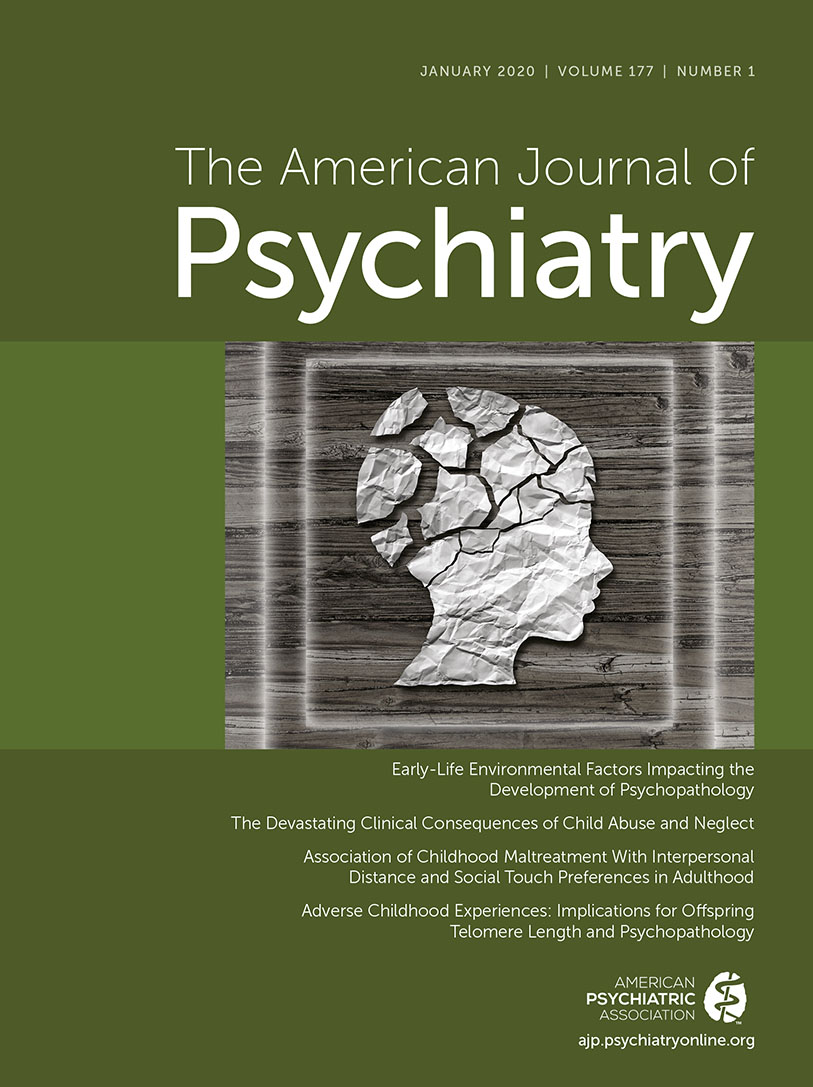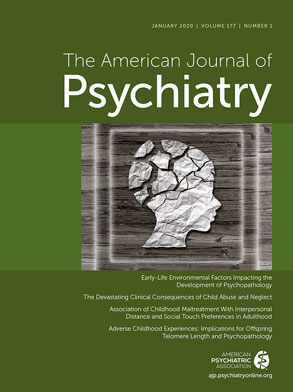In this issue, Maier et al. (
1) present results from a fascinating study that is a pleasure to read. Unlike the vast majority of studies on the clinical and neurobiological consequences of maltreatment, the authors did not focus on the usual, albeit important, array of symptoms or diagnoses, such as depression, anxiety, and substance use. Rather, they took a deeper dive to ascertain how maltreatment may modify some key individual differences that may underlie psychiatric vulnerabilities. Briefly, they found that relatively severe exposure to childhood maltreatment was associated with preference for increased interpersonal distance and less pleasurable responses to touch, particularly moderately fast touch that is involved in tactile discrimination. Further, they found that moderately fast touch was associated with exaggerated brain activation in the right superior temporal gyrus and right posterior insula, which correlated with lower comfort ratings. In addition, they report that slow, generally comforting touch, was associated, in the severely maltreated, with a blunted right hippocampal response.
As this study suggests, we as a profession may be paying insufficient attention to the role that sensory processing problems play in our patients and how they may contribute to life difficulties or underlie their more overt clinical symptoms. There are, however, a few disorders in which sensory processing problems are quite apparent. In autism spectrum disorder, problems with hyperresponsiveness, hyporesponsiveness, or sensory preoccupation are often overt and clearly interfere with daily life (
2). Problems with tactile sensitivity or defensiveness also often come to light clinically in individuals with attention deficit hyperactivity disorder (
3) or developmental disabilities (
4).
Another clear example of altered sensory perceptions is conversion disorders. Since antiquity, there has been an understanding that exposure to trauma or severe psychological distress can lead to hysterical symptoms of blindness or paralysis. The idea that anxiety is converted into physical symptoms emerged from the work of Charcot, Freud, and Janet and served as a foundation for psychoanalytic theory (
5). Conversion disorders—or perhaps, preferably, functional neurological symptom disorders—are the second most common reason for neurological outpatient visits, after headache (
6). These are diagnoses of exclusion, where no known cause, such as a lesion or tumor, is discernible and often where the distribution of symptoms (e.g., across dermatomes) does not conform to known anatomical pathways.
Childhood maltreatment is recognized as a major risk factor for functional neurological symptom disorders (
7). However, our understanding of the role of maltreatment or early-life stress as a contributing factor is rapidly evolving as we progressively delineate the potential effects of these experiences on trajectories of brain development. This is perhaps most clearly seen in the relationship between early experience and the development of sensory systems.
Briefly, sensory systems are critical filters to the outside world, and it is well established, since the Nobel Prize–winning work of Hubel and Weisel (
8), how malleable these systems are to experience during developmentally sensitive periods. How sensory systems may be affected by exposure to childhood maltreatment came to light in a series of studies that we conducted some years ago. Our primary interest was the question of whether the type of maltreatment mattered from a brain development standpoint, or whether different types of maltreatment all fell into the category of general stressors. Hence, we sought to delineate whether there were specific alterations in brain structure that could be attributed to different types of maltreatment. For these studies, we endeavored to recruit participants who were predominantly exposed to only one type of maltreatment. Hence, we conducted neuroimaging studies in individuals who reported exposure to high levels of parental verbal abuse, to visual witnessing of multiple episodes of interparental violence, and to extrafamilial sexual abuse. Morphological and diffusion tensor imaging data were analyzed using voxel-based morphometry and tract-based spatial statistics to provide an unbiased whole brain assessment of significant differences between individuals who reported having experienced these events and unexposed control subjects.
We found that exposure to high levels of parental verbal abuse was specifically associated with alterations in gray matter volume in the left auditory cortex (
9) as well as reduced integrity of the arcuate fasciculus (
10), which serves to interconnect Broca’s and Wernicke’s areas and is a major language pathway. Visually witnessing domestic violence, in contrast, was associated with reductions in gray matter volume in portions of the visual cortex (
11) and with reduced integrity of the inferior longitudinal fasciculus (
12), which interconnects the visual cortex and the limbic system and helps mediate emotional and memory responses to visual stimuli. We also found that sexual abuse was associated with reduced gray matter volume in the visual cortex, particularly in portions involved in facial recognition (
13). Similarly, Heim et al. (
14) found that while exposure to emotional abuse was associated with selective thinning in regions of the cortex involved in emotion regulation, penetrative childhood sexual abuse in females was associated with selective thinning in portions of the somatosensory cortex conveying touch and feeling from the clitoris and surrounding genital area.
These findings fit with our hypothesis that early stress was not, as prior thinking went, generally damaging the brain but rather was modifying it in very selective ways (
15). Consequently, we view these alterations in sensory systems and corticolimbic structures as phenotypic adaptations, selected through the course of evolution, to facilitate childhood survival and reproductive success in malevolent circumstances (
16). However, these adaptations may be counterproductive at later ages or under different circumstances. Heim et al. (
14) speculated that thinning of the somatosensory cortex may protectively shield the child from this highly adverse experience but may lead later in life to impairments in sexual perception and to sexual dysfunction.
In their article in this issue, Maier et al. have done an excellent job of placing their findings into this type of framework. A preference for increased interpersonal distance may function, in individuals who are on high alert as a consequence of maltreatment, to adaptively facilitate escape. Further, the authors found that an increased interpersonal distance preference in individuals with relatively severe childhood maltreatment was linked to both general touch aversion and discomfort with discriminative touch. Together, these findings may help explain why childhood maltreatment is often associated later in life with social avoidance, social withdrawal, and isolation.
Unfortunately, Maier et al. were not able to ascertain whether these alterations in tactile perception were associated with exposure to particular types of maltreatment. Individuals are often exposed to multiple types of adversity, and the high degree of collinearity between exposure types can preclude their delineation using standard statistical techniques. We have found that alternative approaches can effectively sort out the importance of specific types of maltreatment in highly collinear data (
17) and have confirmed the validity of these approaches in simulation studies. The most useful technique, random forest regression with conditional inference trees, uses artificial-intelligence predictive analytics and was specifically designed to be highly resistant to effects of collinearity, and it provides an unbiased assessment of the importance of underlying predictor variables (
18). As a note, these techniques may work better with the Maltreatment and Abuse Chronology of Exposure scale than the Childhood Trauma Questionnaire, as the former collects information on more types of adversity, as well as timing, to provide a richer data set for analysis. It would be of interest to know whether the reported modifications in tactile response were associated with exposure to forms of adversity associated with aversive physical touch (physical abuse, sexual abuse) or were perhaps associated with inadequate touch as a consequence of neglect.
The key take-home message is that maltreatment (and other forms of early experience) acting during developmentally sensitive periods will produce enduring modifications in sensory perception, which may have widespread effects on interpersonal relationships and mental well-being. These sensory processing differences may be subtle, as in the present study. However, they may be more overt, for example, in the form of sexual dysfunction in individuals with histories of childhood sexual abuse. Finally, they may be embedded in our brain network architecture in ways that lead, under certain circumstances, to the emergence of functional neurological symptom disorders through alterations in functional connectivity and electrical activity (
19) not discernible on standard neurological assessments.
Studies on the neurobiological consequences or correlates of early-life stress have been, in most instances, replicable across laboratories and are typically associated with larger effect sizes than studies on the relationship between psychopathology and neurobiology (
16). Childhood adversity is now recognized as a leading risk factor for many forms of psychopathology. However, as we proposed some years ago, maltreatment may be more than a risk factor; it may be an etiological factor producing pathophysiologically distinct ecophenotypic variants (i.e., a modified phenotype resulting from environmental influences) of major psychiatric disorders (
20). Innovative studies, like that of Maier et al., that explore the relationship between maltreatment and individual differences hold great promise for advancing our understanding by integrating the associations between early experience, neurobiology, individual differences, psychopathology, and social interactions.

